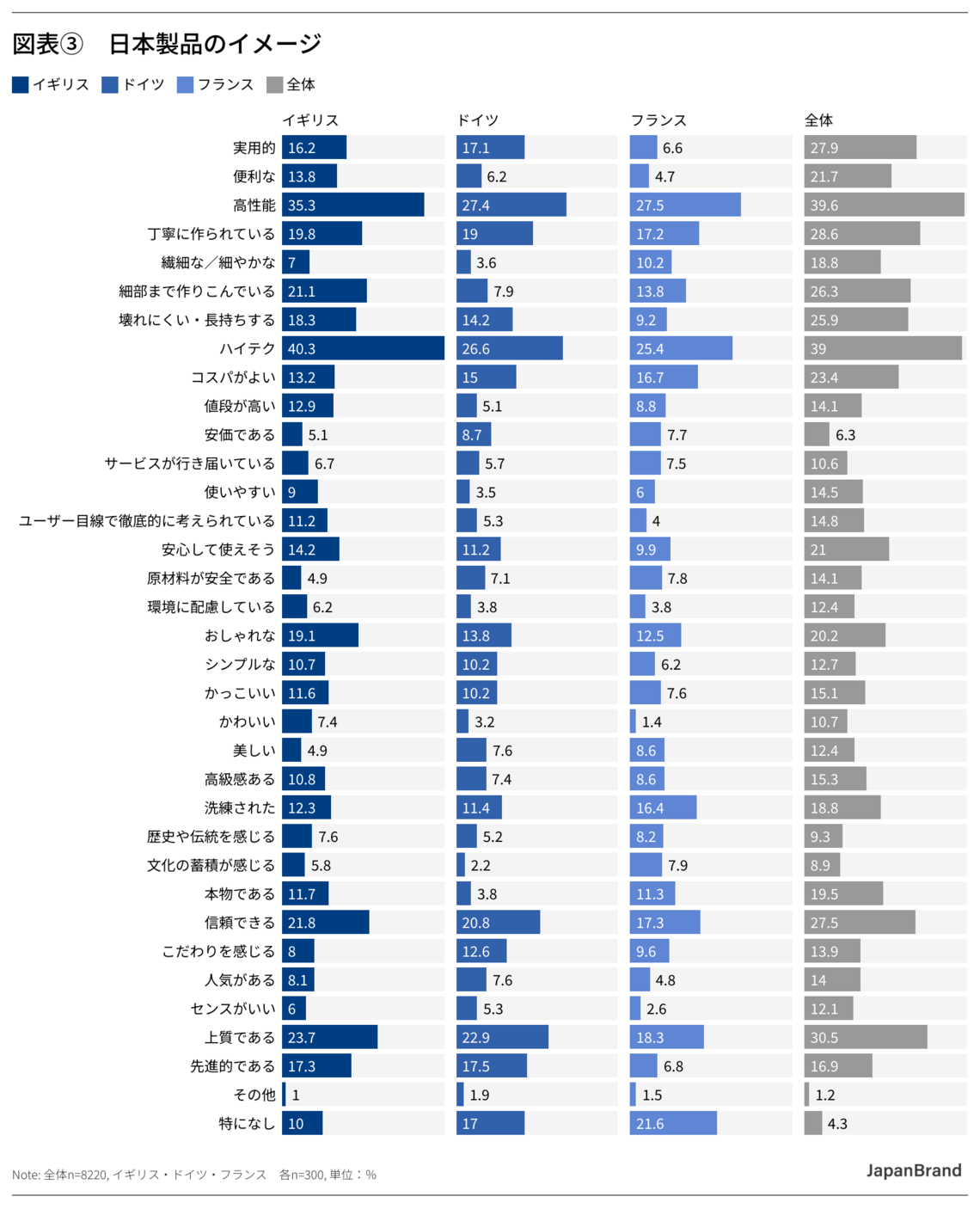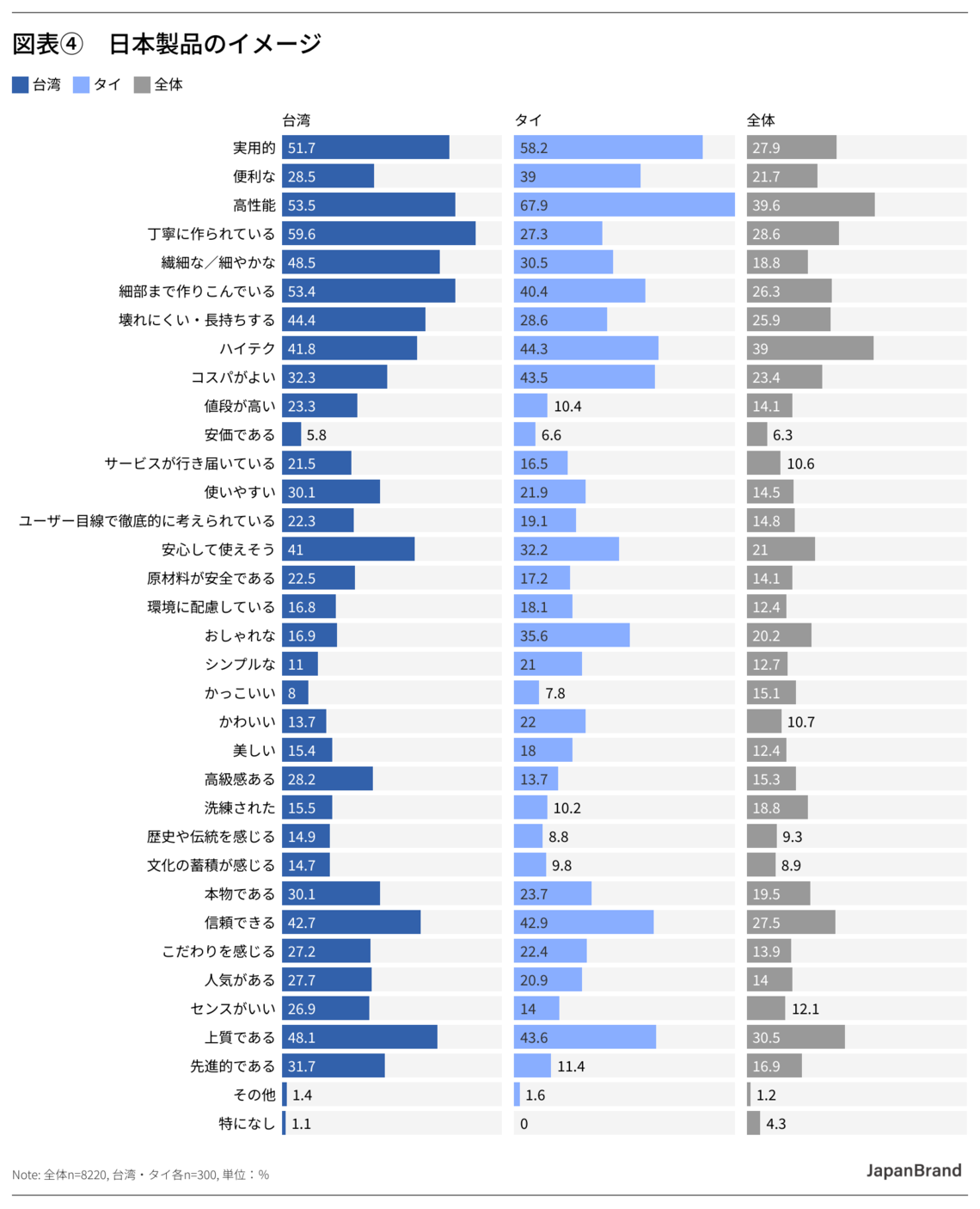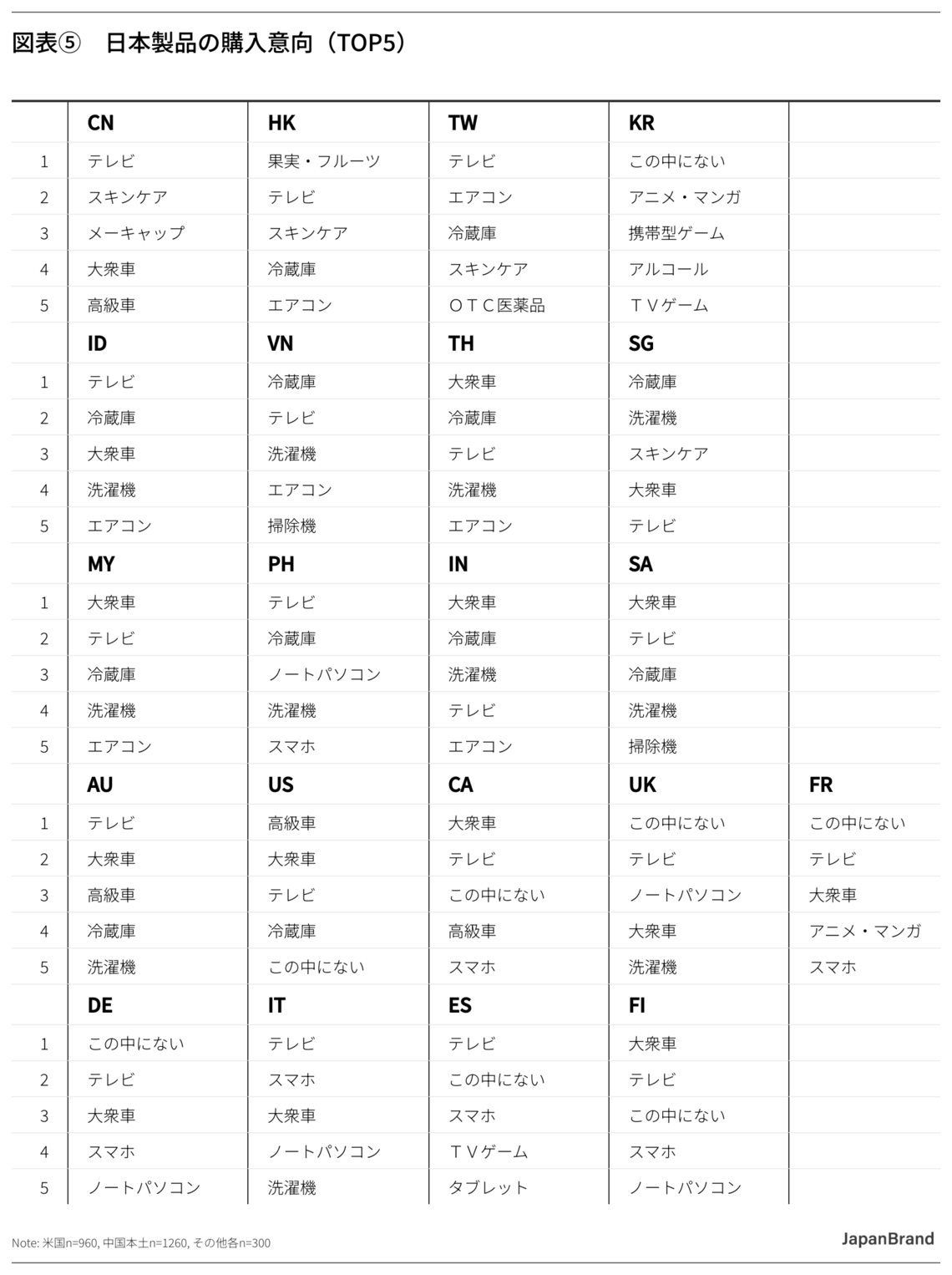Note: This website was automatically translated, so some terms or nuances may not be completely accurate.
Planners Decode the Appeal and Challenges of Japan Brands: "Japanese Products" Edition
This series examines the current state of the Japan Brand and Japan's future potential using the latest data from Dentsu Inc.'s Japan Brand Survey ( overview here ), a proprietary survey targeting high- and middle-income consumers overseas that underwent a major renewal in 2022.
This installment focuses on "Japanese Products." Lee, a member of Dentsu Inc.'s Team Cool Japan responsible for the Japan Brand Survey's project design, examines the appeal and challenges of "Japanese Products" from a planner's perspective.
<Table of Contents>
▼The Power of Free Thinking and Collective Intelligence
▼Logos, Ethos, Pathos
▼Bird's Eye View and Bug's Eye View
▼Aiming for the Idea, Yet Never Underestimating Reality
▼Know Your Enemy and Know Yourself, and You Will Never Be Defeated
▼The Knowledge of Ignorance
The Power of Free Thinking and Collective Intelligence
Before getting to the main topic, I'd like to touch on the social context.
Since the latter half of the 2010s, the notion that Japan is lagging behind in digital transformation has become increasingly common. Furthermore, regarding the social environment, arguments frequently surface that compared to Japan's economic golden age, a sense of stagnation and stagnation prevails, and both individuals and organizations have lost the leeway to enjoy breathing room.
That said, each of us caught in this environment cannot simply be bystanders. Many are likely struggling in their respective positions, desperately seeking solutions.
Strangely enough, despite the uncertainty, complexity, and lack of precedents or clear answers, we find ourselves, for better or worse, rushing headlong to pursue "clarity we can understand." There's a growing tendency to value approaches that frame things in binary oppositions—left brain vs. right brain, digital vs. analog, global vs. domestic, traditional corporations vs. startups, market-in vs. product-out, lifetime employment vs. performance-based systems, top-down vs. bottom-up—and attempt persuasion through seemingly logical analysis.
However, in the irreversible societal currents brought by the VUCA era and the novel coronavirus, confronting the grand theme of the Japan brand's current position and potential requires more than the wisdom of one individual, a single winning formula, or a single approach. We believe breaking through the barriers Japanese products face is no longer possible with these alone, and creating new appeal is harder than climbing to the heavens.
One data point, multiple interpretations. This series may be far from offering answers that everyone instantly agrees with, but we hope it serves as a catalyst ( ) to draw out diverse insights. With respect for free thinking and the power of collective intelligence.
Logos, Ethos, Pathos
In his "Rhetoric," Aristotle asserted that three elements are indispensable for persuading people: Logos (logic), Ethos (character/trust), and Pathos (emotion/empathy). The essence of purchasing a product is precisely the multiplication of Logos, Ethos, and Pathos.
This time, we present the product image as:
① Functionality
② Price
③ Service
④ Usability
⑤ Safety
⑥ Brand Image
⑦ Design Appeal
We conducted a high-resolution survey by categorizing these into 7 categories and further breaking them down into 33 items.
Here, we will add our analysis while using the three essential elements for Japanese products (Logos, Ethos, Pathos) as our framework for thought.
A. Logos: "Functionality, Price, Service, Usability" (Logic) – where rationality and comparative evaluation strongly influence decisions
B. Ethos: "Safety" representing the character and trustworthiness of the product/company (=Personality/Trust)
C. Pathos: "Brand image and design aesthetics" reflecting the brand's narrative and aesthetics (= emotion/empathy)

A. Logos: "Functionality, Price, Service, Usability" (Logic) – where reason and comparative evaluation strongly influence decisions
First, over 70% of respondents hold the image that Japanese products are "superior in functionality." This means Japanese products demonstrate significant advantage over foreign products in the "Logos" aspect.
Furthermore, within functionality, "high performance" and "high tech" received the highest ratings, significantly outpacing other items.
Other characteristics common to many Japanese products, such as "meticulous craftsmanship," "practicality," "attention to detail," and "durability/long-lasting," were also highly valued.
B. Ethos: "Safety" representing the character and trustworthiness of the product/company (= character/trust)
Next, regarding safety, which corresponds to "ethos," the image of "seeming safe to use" is strong, and the sense of "reliable Made in Japan" is firmly established.
C. Pathos: "Brand Image/Design Appeal" reflecting the brand's story and aesthetics (= Emotion/Empathy)
Regarding brand image and design, defined as "Pathos," "high quality" and "reliability" received the highest ratings. This can be seen as reinforcing the "Logos" (high performance, high tech) and "Ethos" (reassurance) aspects.
On the other hand, items like accumulated history and culture, good taste, and beauty scored relatively low. When viewed through the lens of brand narrative and aesthetics, a slight sense of incompleteness remains.
Bird's-eye view and insect's-eye view
We often casually use broad geographical categories like "Western countries," "ASEAN," or "Asia." In certain situations, such categorization is indeed very convenient.
However, from the perspectives of marketing and cognitive psychology, such classifications often become sources of error and preconceptions. There is a risk that they unnecessarily oversimplify thinking and approaches that should fundamentally engage with complexity and diversity.
In this survey, even among Western European countries, significant differences were observed in perceptions of Japanese products across many categories.
For example, regarding "high-tech," the perception in the UK was nearly on par with the overall average, significantly higher than in Germany and France.
Conversely, regarding "no particular image," France had the highest proportion (about 1 in 5). In other words, this indicates a relatively high percentage of French people who neither show particular interest nor concern for Japanese products. For those who admire France, this is truly a disappointing result.

Turning to Asia, significant differences also exist between Taiwan and Thailand, both of which hold high favorability toward Japan. In Taiwan, images like "meticulous craftsmanship," "delicate," "durable/long-lasting," "luxurious," and "advanced" are strongly held, whereas this was not as pronounced in Thailand.
For Thai consumers, Japanese products are more strongly associated with "high performance," "good value for money," and "stylish." Observing these subtle differences reveals that even within neighboring Asian regions, it is necessary to adjust the points of appeal.
Striving for the ideal, yet never neglecting reality
In Parts 1 and 2, we introduced various data using inbound tourism as a lens. According to the Japan Tourism Agency and the Japan National Tourism Organization (JNTO), East Asia accounted for 70.1% (※1) of all foreign visitors to Japan in 2019 and represented 64.4% (※2) of total spending by these visitors.
The fact that East Asia represents the largest volume segment for inbound tourism is both a reality and an undeniable truth. The phenomenon of people gathering from geographically and culturally close neighboring regions is observed in many countries and is by no means unique to Japan.
While firmly grasping this reality, I believe Japan must extend both its temporal and spatial horizons to discuss and make decisions regarding the ideal vision (Idea) it should pursue as a tourism-oriented nation. Needless to say, a gap inevitably exists between this Idea and reality. Inbound tourism, not limited to travel, has a broad base. Naturally, the ideal vision differs depending on the business sector involved, and it's easy to imagine that the accompanying gap is not uniform either. Data suggesting this gap was also confirmed in this survey.
When surveying purchase intentions for Japanese products, nearly all Asian countries and regions saw product categories representing Japan brands—such as televisions, refrigerators, washing machines, mass-market cars, and air conditioners—dominate the top rankings. The sheer numbers alone convey the high level of interest.
In contrast, within Western cultural spheres, while mass-market cars and televisions appear, unfortunately, "None of the above" also ranks highly. Despite presenting a nearly comprehensive list of major product categories, deliberately selecting "None of the above" signifies a lack of interest.
Particularly in the UK, Germany, and France, the lack of desire to purchase Japanese products ranks among the worst in the Western world. This phenomenon is also visible in inbound-related metrics. When aiming for business growth through attraction promotion or sales expansion targeting Western countries, extraordinary ingenuity in "Logos (Logic), Ethos (Character/Trust), and Pathos (Emotion/Empathy)" will undoubtedly be required.
Know your enemy and know yourself, and you will fight a hundred battles without danger.
The period around the 5th century BC, when the "Art of War" by Sun Tzu—widely read even in Japan—is said to have been written, was roughly the same era as that of ancient Greek philosophers Socrates and Plato. It is truly fascinating that military strategy from such ancient times can be directly applied to today's competitive strategies.
Inversely proportional to the extension of human lifespan, the period during which a company can continue winning and remain among the so-called winners has shortened compared to the past. However, as long as free competition is necessary, efforts to win and survive must be made. As the subheading suggests, here we aim to highlight the characteristics of Japanese products from the perspective of product image through comparison with products from other countries (German, French, Chinese, and Korean).
First, I will briefly explain the product images of the four countries other than Japan.
German products are closest in image to Japanese products. On many evaluation axes, the two are neck and neck, suggesting German products may be the true rival for Japanese goods.
French products stand out for their brand image and design, receiving exceptionally high ratings for "stylish," "luxurious," and "beautiful." This largely aligns with the traditional image associated with France.
Chinese products maintain their traditional image of being "inexpensive" and "simple," with "inexpensive" scoring particularly high. However, in areas like "easy to use," "good value for money," and "popular," they are largely on par with Japanese products.
Korean products seem to be perceived as "stylish," "cool," and "beautiful." This is likely due to the increasing competitiveness of Korean manufacturing itself, coupled with a strong focus on global expansion. A key factor is the successive global hits produced in content (dramas, movies, music, etc.), which is the cornerstone of soft power.
Now, regarding the crucial Japanese products themselves, has their brand value fallen to the point of pessimism when compared to these competitors? Absolutely not. In fact, there is absolutely no need to feel inferior.
The facts speak for themselves: Japanese products are highly valued, particularly for their functionality. They are clearly superior to products from other countries in key evaluation areas such as "high-tech," "high performance," "meticulous attention to detail," "durability and longevity," "superior quality," and "reliability."

However, as already demonstrated by Japan's lagging behind in building a digital ecosystem, the functional catch-up and overtaking by certain countries where innovation occurs more readily than in Japan will inevitably become a reality sooner or later. The spirit of pursuing the "Idea" of manufacturing centered on advanced technology deserves great respect. Yet, without being bound by it, the question increasingly arises: How can we know the enemy and know ourselves? How can we observe the "reality" of the ever-changing market with an open mind and make agile course corrections?
The Knowledge of Ignorance
Including experiences both public and private, many people unconsciously tend to underestimate the diversity and differences of other countries or show a quiet rejection of what is different.
In Japan's case, the excuse "Japan is an island nation" is often used. While somewhat understandable, it somehow fails to evoke deep empathy. This is because, as an island nation off the Eurasian continent, Japan is a rare "mille-feuille nation" layered with diverse cultures from throughout history and across the globe, possessing unparalleled depth and richness. Observing without bias reveals that foundations for diversity and inclusion are already present throughout society.
I suspect the core issue lies less in the geographical factor of being an island nation and more in the unique success achieved through uniformity during a specific historical period, and the strong comfort zone that success created. Ultimately, within an era of seemingly limitless golden age and a highly homogeneous, high-context environment, there are few opportunities to relativize differences within society, organizations, and individuals. This can lead to a structure where people "are unaware that various differences objectively exist."
This phenomenon is not unique to Japan; it can occur in any country or group. However, its detrimental impact on the long-term prosperity of Japan's brands, including its products, is as clear as day. The most problematic pattern is "not realizing that one is unaware of the existence of differences."
Whether it's "not knowing differences exist" or "not realizing one doesn't know differences exist," Socrates' ancient concept of "the wisdom of knowing one's own ignorance" from the 5th to 4th century BC offers a highly relevant starting point for resolution. Essentially, it means beginning from the position of "knowing that one doesn't know differences exist."
Considering that this wisdom remains valued over 2000 years after ancient Greece, drawing insights from the sages' thinking is essential wisdom, especially in our highly uncertain times.
Above, drawing on timeless teachings from our predecessors—persuasion techniques, multifaceted observation, ideals versus reality, contrast, self-awareness and inquiry—we've analyzed consumers in a volatile world and Japanese products, using the Japan Brand Survey as a foundation for recognizing and noticing differences.
In our daily pursuits, are we becoming narrow-minded by rushing to concrete solutions or conclusions? Do we dismiss global perspectives and diversity as irrelevant to our own world? It's entirely possible that, unknowingly, blind spots in our cognition darken the fertile margins of our individual perspectives. To prevent this, alongside diversifying resources and approaches, we must intentionally create mental margins. This may seem somewhat unconventional and abstract, but I hope it offers at least some reference. Next time, we'll explore the world of food.
Source:
※1: Calculated based on Japan National Tourism Organization (JNTO) "Number of Overseas Visitors to Japan in 2019"
※2: Calculated based on Japan Tourism Agency "Annual Report on Consumption Trends of Inbound Tourists 2019"
Page URL: https://www.mlit.go.jp/kankocho/siryou/toukei/content/001345781.pdf
【Contact for Inquiries Regarding This Matter】
Dentsu Inc. Japan Brand Survey Project Secretariat
japanbrand@dentsu.co.jp
【About the Dentsu Inc. Japan Brand Survey】
An independent survey initiated by Dentsu Inc. in 2011 to understand how the Japan brand was perceived globally following reputational damage to Japanese agricultural and marine products and inbound tourism caused by the Great East Japan Earthquake. Led by Dentsu Team Cool Japan and the Public Account Center, it underwent a major renewal in 2022 with changes to target areas and survey content.
【Dentsu Inc. Japan Brand Survey 2022 Overview】
・Target Areas: 22 countries/regions (United States, Canada, China, South Korea, Taiwan, Hong Kong, Singapore, Thailand, Malaysia, Indonesia, Vietnam, Philippines, India, Australia, Saudi Arabia, United Kingdom, France, Germany, Italy, Spain, Russia, Finland)
・Respondent Criteria: Middle-to-high income individuals, men and women aged 20s to 50s
・Sample Size: 8,220 people (United States = 960, China = 1,260, Other countries/regions = 300)
・Survey Method: Online survey
・Survey Period: December 2021 - January 2022
Was this article helpful?
Newsletter registration is here
We select and publish important news every day
For inquiries about this article
Back Numbers
Author

Li Shunshi
Dentsu Inc.
First Business Transformation Bureau
Planner, Producer
Guided by the mottos "Everything flows" and "A blessing in disguise," I engage in diverse projects while transcending specializations in marketing, research, media, global operations, and project management.







